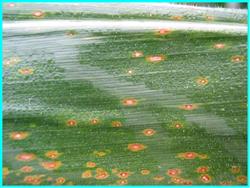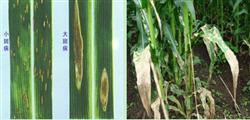Occurrence and Control of Curvularia Leaf spot in Maize

Corn Curvularia leaf spot, also known as yellow spot disease, farmers called yellow leaf disease, is another important disease of maize in our province in recent years after big spot, small spot and rust. After the occurrence of Curvularia leaf spot, the leaves were covered with disease spots, which withered and died, which seriously affected the growth of maize and reduced the yield. First, the occurrence of symptoms: the disease mainly harms corn leaves, but also can harm leaf sheaths and bracts. The lesions are initially water-immersed or yellowish translucent spots, and then enlarge into round, oval, fusiform or elongated spots, which vary according to the resistance of different varieties, generally 1-5mm in length and 1-2mm in width, and vary in size; the lesions are pale and translucent in the center, with brown bands around them, and obvious yellow halos on the periphery; multiple spots are connected to form large spots, and the front part of the leaf or leaf edge is necrotic. The disease spots were not obviously segmented on the leaves. Black mildew can be produced in moist conditions, that is, conidiophores and conidia of pathogens. 2. Pathogens: the pathogens are Curvularia lunata and Curvularia unequal, which belong to the subphylum Curvularia. The optimum temperature for pathogen growth is 28-32 ℃, the optimum temperature for conidia germination is 30-32 ℃, the optimum humidity is saturated humidity, and the relative humidity below 90% rarely germinates. Third, the law of occurrence: the pathogen overwintered as mycelium in the diseased tissue and as conidia. The bacteria-carrying corn straw and weeds were the initial infection sources of the disease; the mycelium produced conidia, which were transmitted to corn leaves by airflow and Rain Water for re-infection. Curvularia leaf spot of maize is a typical disease at adult stage. The resistance of maize to Curvularia leaf spot is strong at seedling stage and weakens with plant growth. The disease in the field in Henan began from late July to early August, and the peak of the disease occurred after the heading of maize, that is, from mid-late August to early September. Because the incubation period of the disease is short (2-3 days), an infection cycle can be completed in 7-10 days. in case of high temperature and high humidity, it can occur in a large area in a short period of time, and the disease is more serious in low-lying paddy fields and continuous cropping fields. 4. control methods: the control strategy of corn Curvularia leaf spot is a comprehensive measure based on planting disease-resistant varieties and supplemented by chemical control. 1. Plant disease-resistant varieties. According to the identification of resistance, the more resistant varieties are Nongda 108, Zhengdan 14, Nongda 951, Zhongyu 4, Yedan 12, Zhengdan 7, Danyu 13, and the more serious ones are Yedan 13, Danyu 20 and Zhengdan 958. 2. Strengthen cultivation management and reduce the source of overwintering bacteria. Reasonable rotation, reasonable close planting, strengthen management, improve plant disease resistance; timely clean up the disease and debris of corn after harvest, centralized treatment, reduce the source of primary infection. 3, chemical control: in the initial stage of the disease, spraying control when the field incidence rate is 10%, and the effective agents are Nonglituo, Qingyi color, methyl carbendazim, carbendazim and so on. When the climatic conditions are suitable for the disease, the disease will be prevented and treated for the second time a week later.
- Prev

Control techniques of Maize Leaf spot and Leaf spot
Corn leaf spot and small leaf spot are mainly harmful to leaves, and sometimes infect leaf sheaths and bracts. Leaf spot can not only damage the above-mentioned parts, but also damage ears. In many areas, these two diseases are collectively referred to as "corn spot". 1. Symptom recognition: the typical symptom of corn leaf spot is the rapid expansion of small spots and the growth of large edges.
- Next

The causes of Cotton growing excessively and its Control methods
The causes of Cotton growing excessively and its Control methods
Related
- The first cup of black tea in spring, the flavor and history of tea gardens in Kenya, Africa
- The computer can not only choose potatoes, but also grow tea rice. AI will grow winter oolong tea champion.
- It is not only the inflated tea bitten by insects, but also engraved with the four seasons tea in Beipu.
- The Oriental Beauty Tea Festival in Zhuxian County takes the stage at the weekend to experience the plus-size feast of oil tea.
- & quot; Oriental Beauty Tea & Exploration of Emei in Hsinchu, the hometown of quot;
- The new variety of strawberry "Tainong 1" dessert is the first choice with mellow aroma. Crimson gorgeous
- History of Tea in Taiwan: from Wild Inner Mountain to Export Tea Garden
- Two types of Taiwan Oriental Beauty Black Tea won the British three-Star Award for Childhood Tea Xiang Zhang Jiaqi changed from pilot to champion tea maker.
- Banana species and varieties: the planting history of Taiwan Xianren banana and dwarf banana is long, is banana disease resistant?
- Coffee planting Technology: Qianjie Coffee from Seedling to harvesting

